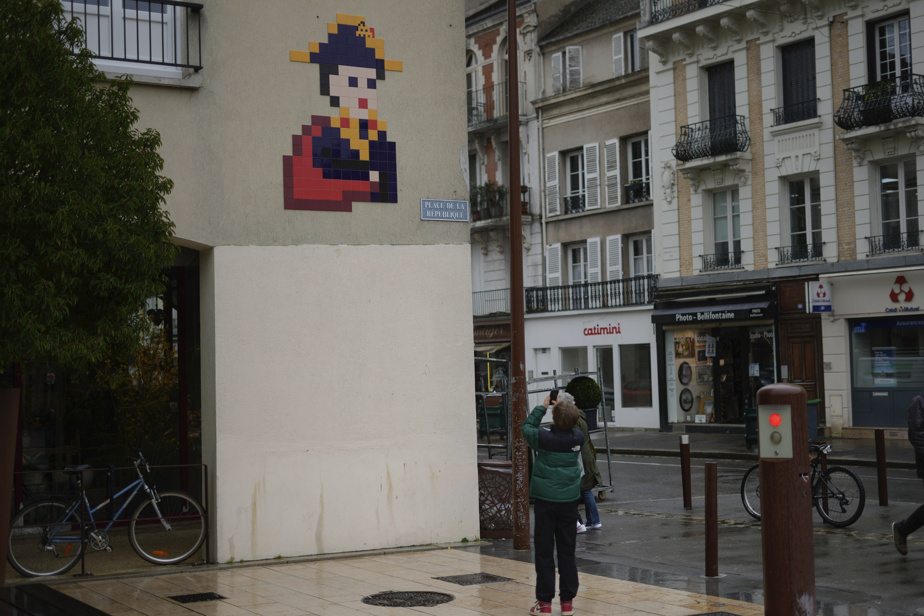(Paris) It could be a new sport for the Paris Olympics: tracking down the mosaics that a mysterious artist calling himself “Invader” has cemented on walls in the French capital, around the world and even transported aloft at the International Space Station.
Vincent Giraud, one of the artist’s Parisian admirers, is already a passionate player. He downloaded Invader’s cellphone game “Flash Invaders,” which awards points to users who find and photograph the colorful and original pixel art.
Quickly passionate, Mr. Giraud found 1565 in just one year, accumulating so many points that he propelled himself into the top 1000 of the rankings, out of more than 360,000 players.
“In a few months, I found and flashed everyone in Paris,” said Mr. Giraud, nicknamed Vince-Vader. Hunting for Invader mosaics, looking for them on walls, sidewalks, bridges and even at the top of the Eiffel Tower, is “another way to experience the city,” he says.
In other words, when Olympic visitors flock by the millions to Paris for the July 26-August 11 event, they will be crowding the grounds of France’s most international, invasive and intriguing contemporary street artist. It will be one invasion confronting another.
Like Banksy, the British street artist to whom he is sometimes compared, Invader is elusive, fiercely protective of his anonymity and operating on the fringes of illegality. It comes, sticks and disappears into the night, leaving behind its iconic pixelated mosaics made mainly of small ceramic and glass tiles.

PHOTO THIBAULT CAMUS, ASSOCIATED PRESS
Most of the works resemble the aliens from the arcade game Space Invaders. Others are wonderfully elaborate, like still lifes of fruit or, in New York, portraits of Lou Reed and Andy Warhol. Some refer to pop culture – Spiderman, Star Wars, Bugs Bunny, Ninja Turtles, pizza, etc. And some allude to in-depth research, notably the portrait of guitarist Django Reinhardt in front of the house where he lived, south of Paris, in Samois-sur-Seine.
Since the first cataloged mosaic depicting a blue Space Invader was erected on a Paris street in 1998, numbered PA_01, Invader has colonized the world. Today there are more than 4,000 of his mosaics in cities and towns on every continent except Antarctica.
London, Tokyo, Los Angeles and other cities were invaded in 1999; New York and Geneva in 2000; Hong Kong in 2001; then Berlin, Bangkok and Melbourne.
The 4000e mosaic was glued to a brick wall in Potosí, 4,000 meters above sea level in the Bolivian Andes, in 2021. The European Space Agency installed Invader’s Space2 mosaic aboard the International Space Station in 2015.
The imprint in Paris
In Paris – by far the place where he is most present – the artist’s footprint is larger than ever in the run-up to the Olympic Games.
A new exhibit in a disused multi-story building features one of his painted rasterizations on its roof, visible via satellite on Google Maps. Using a telescope, visitors can also observe, across the gray roofs of Paris, Invader’s final milestone: its 1500e mosaic in the host city of the Olympic Games and its suburbs.
The work PA_1500 was unveiled in February on an outdoor fireplace at the Center Pompidou, the most important contemporary art museum in Paris. Unlike most of his works which he installs without asking, Invader requested and received permission from the museum to cement the red and white Space Invader-like alien.
“It’s a symbol. It’s number 1500. It’s Paris,” said Alexandre Aumis, director of security at the iconic building. “It has to be here. »
Mr. Aumis is a new convert to “Flash Invaders.”
“I run a lot in Paris, so I see them everywhere. »
Some of those who know Invader say they expect him to create more surprises for the Olympics, perhaps installing new Games-themed mosaics.
“The invasion is the 15 million people who will arrive in Paris for the Olympic Games. It’s a lot. Among them, there will obviously be Invader fans,” said Fabrice Bousteau, editor-in-chief of Fine Arts Magazine and curator of the latest Invader exhibition.
“So there will be this meeting between two cultures. »
